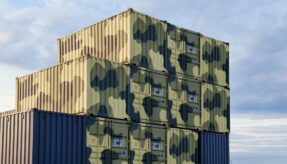
Supply chains are more vulnerable than ever to disruptions caused by geopolitical events. This blog highlights the critical challenges and strategies for navigating these risks, emphasizing the importance of preparation and resilience.

Setting the geopolitical context
The current global geopolitical landscape, fraught with complexities, directly impacts supply chains. Key issues include policy and economic changes following the US election, export restrictions on essential metals, hostilities in the Red Sea, and the ongoing conflict in the Middle East. Additionally, the war in Russian and Ukraine has exacerbated supply chain disruptions, leading to material shortages and price increases that predate the pandemic. These events underscore the perilous complexity of sanctions, anti-corruption measures, and other compliance areas.
Major challenges for supply chains
Supply chains now face numerous challenges, including labour shortages, increased competition for skilled resources, and the need for additional inventory of critical materials. Inflation complicates price negotiations with suppliers, while cyberattacks threaten sensitive data and documents. Limited visibility into suppliers and their products intensifies these issues. Environmental and social responsibility performance, along with susceptibility to climate disasters, adds another layer of complexity.
Proactively mitigating adverse effects
To mitigate these adverse effects, organizations can adopt several strategies. Foreign direct investment (FDI) screening can protect key industries from foreign interference, while a risk-informed sourcing plan can help manage supplier performance and disruption risks. Improving cyber resilience and mitigating sanctions evasion risks can strengthen agencies’ ability to proactively stay ahead of potential issues, while public-private partnerships are becoming more important for access to new technologies and expertise, with the potential to foster innovative ideas for startups. Reducing dependence on imports through onshoring or sourcing from friendly countries, promoting sustainable practices, and investing in new technologies are also becoming essential for long-term resilience.
Pursuit and evasion strategies in malign influence activities
Efforts to address the unauthorized trade of sensitive technology have been a focus of international concern. This includes attempts to acquire technology that could potentially be used in military operations, with various countries being implicated in complex networks designed to bypass export controls. These networks can involve intricate supply chain arrangements and the use of countries with less stringent regulations on technology transfer. The technology in question often includes electronic components critical for the development of advanced weaponry, such as drones, cruise missiles, and tanks. The challenge lies in the opaque nature of these transactions, making it difficult for international bodies to monitor and intervene effectively.
In response to these challenges, initiatives have been undertaken to enhance the monitoring and enforcement of export controls. For example, in February 2023, the United States introduced the “Disruptive Technology Task Force.” This initiative aims to utilize advanced data analytics and comprehensive intelligence gathering to identify and take action against attempts to illicitly acquire sensitive technologies. Following this, concerted efforts by the US, UK, and EU from May to July 2023 led to the identification of specific dual-use and advanced technology items that are of high interest for procurement in efforts related to weapons development.
These measures reflect an ongoing commitment to safeguarding sensitive technologies from unauthorized use, emphasizing the importance of international cooperation and the application of innovative strategies to address complex challenges in global security.
The European landscape as a proxy for global trends
The European Union faces similar challenges, with 80% of criminal networks misusing legal business structures for illicit activities. Digital components are involved in 80% of these crimes (source: Europol/European Commission). Public agencies can equip themselves with modern data, technology, and the necessary tools to investigate evolving crime and sanctions evasion methodologies effectively. Fraud accounts for 40% of all crimes committed in the UK, highlighting the need for robust investigative capabilities.
Conclusion
Navigating supply chain risks in a complex geopolitical landscape requires a multifaceted approach. Companies must be proactive in understanding the geopolitical context, addressing major challenges, and implementing strategies to mitigate adverse effects. By leveraging advanced data analytics, fostering public-private partnerships, and promoting sustainable practices, businesses can build resilient supply chains capable of withstanding the uncertainties of the modern world.
For more information on foreseeing and mitigating supplier performance problems and other key risks, check out the Moody’s Supplier Risk Management webpage or to arrange a meeting to speak to one of our team at DPRTE 2025 on 26-27 March click here
Article submitted by Nicola Passariello, Financial Crime Expert, Moody’s
About Moody’s
Moody’s has long history in developing innovative, high performance risk management solutions and deep datasets. These solutions can help government and defence agencies enhance their compliance, planning, and operations. Our corporate supply chain intelligence identifies financial and ownership networks, assesses supply chain corporate solvency risks, and evaluates defence exports, sanctions, and compliance risks. Operational resilience is bolstered by identifying physical supply chain risks, such as raw material shortages, transport assets, and geographical choke points. Moody’s extensive multi-domain data sets and AI analytics help identify likely demand spikes and concurrent demand surges in response to crises.









